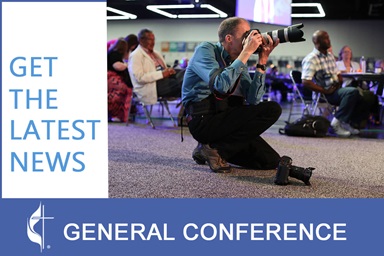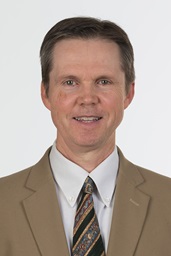Water rushes and swirls through the Red Bird River and, along the way, crashes into Jack’s Creek. Crystal-clear water gushes through a worn, white pipe fed by Horse Creek Spring on Kentucky Highway 80. Coming and going into the Daniel Boone National Forest, waterfalls dance down the sides of rugged, black rocks.
Spring in eastern Kentucky is beautiful. Tall trees burst with lime-green leaves. Standing under them are the more delicate blooming red bud and white and pink dogwood trees. The lush countryside is deceiving; most of the beautiful clear water flowing freely is contaminated and unsafe even to dip your toes in and certainly not to sip.
It brings to mind the famous line from The Rime of the Ancient Mariner, “Water, water, everywhere, Nor any drop to drink.”
When the water is bright orange, it is easy to tell it is contaminated. When it looks pure and clear, it is not so easy to identify.

Clean drinking water will be dispensed from this kiosk at the Red Bird Missionary Conference in Beverly, Ky., when the project is completed this summer. Photo by Mike DuBose, UMNS
That’s why a rectangular concrete box with a bright-red tin roof has Tracy Nolan, director of community outreach for the United Methodist Red Bird Mission, so excited.
A communal water kiosk will soon open on the campus of Red Bird Mission to provide safe water at “pennies for a gallon” for the 6,000 people living in remote Appalachia.
A recent New York Times article labeled Clay County as the hardest place to live in the United States. That title doesn’t sit well with residents who love their sweet Kentucky homes.
Nolan, who is also a nurse, knows unsafe water is a big part of the problem.
Joining hands
Many hands have had a part in the kiosk.
The kiosk reflects teamwork by The United Methodist Committee on Relief, The United Methodist Red Bird Missionary Conference, the University of Tennessee, Appalachia Community Health & Disaster Readiness, the county’s emergency management team and Manchester Memorial Hospital.
Central to the project are nursing, engineering and architecture students who came together to design and build the kiosk.
Architects, engineers and nurses don’t typically talk to each other, said Lauren Oppizzi, a UT nursing student. “Architecture students are very creative, whereas nurses are more information-oriented,” she said.
But students in all three disciplines took classes together. One of the students came up with the brand for the kiosk, “Clean water, Clean life.”
“Being a nurse for 22 years,” said Stacey Tore, a nurse educator at UT, “what was eye-opening for me is that a lot of times when we come up with ideas, we really can’t implement them. Having that architect, that other perspective, made it something we could complete.”
Linda Banks, also a nurse educator at UT, said it was “quite stunning” to discover people in the United States living without basic needs like clean water.
Lisa Davenport, project director of Appalachia Community Health & Disaster Readiness, said the students built the kiosk during their spring break in March.
“If you had been here during the work, you would not have been able to tell who was the nurse, who was the architect [and] who was the engineer,” she said. “They really came together.”
Megan Hayes, project manager, enjoyed the work.
“I’ve put in IVs, but I never drilled into concrete before,” she said.
Hollers and creeks
Clay County’s terrain is part of the problem.
City water lines go to main roads but not up into the “hollers or up the roads, over creeks and across bridges,” Nolan said.
“These low-income families have no disposable income, let alone find somebody that could come to be contracted to do all that work. They couldn’t afford the extra lines.”
Access to clean water is a social justice issue, Nolan said. Lack of safe water leads to poor oral health, gastrointestinal diseases and sometimes even cancer.
“It is difficult for me to see how resilient this community has had to become, how tough many of their lives are,” said Nolan who has been with Red Bird Mission for 18 years. “But they are not complaining.”
Gaining trust
The first year of the three-year project was spent gaining trust from the residents. Those meetings led to testing water sources at 16 sites, both public and private, said Davenport.
Architecture and engineering students drew sketches of homes and took photos, while nursing students interviewed residents about their health concerns.
“A lot of the homes are in poor condition. On a scale from 1 to 10, many of them are 8-10,” Davenport said. “We have gone into some homes that might have plumbing in some areas, but it is not attached to the kitchen. So they are carrying water from the bathroom to cook with which is unhealthy.”
But reports that say Clay County is “the most difficult place to live in the U.S.” can be offensive, Davenport said.
“This is their land; this is home. Although we have identified great needs, we have to disseminate that so people can understand it, and we can help them come up with solutions in a culturally sensitive way.”
The kiosk includes a shelter, benches and a greenhouse. Plans are to hold farmers markets under the roof in the summer.
“Once that little shed becomes a meeting place, I can just see some of our retirees sitting there every morning having their coffee, whittling, talking about the day’s events, what the weather is going to be and going home with a gallon of water,” said David Watson. He is executive director of Manchester Memorial Hospital and director of Emergency Management Services for Clay County.
Davenport sees the opportunity for residents to get clean, fresh water as part of a healing process.
“Now let the healing begin.”
Donations can be made to Red Bird Mission Advance #773726.
Gilbert is a multimedia news reporter for United Methodist News Service. Contact her at (615) 742-5470 or newsdesk@umcom.org.
Like what you're reading? Support the ministry of UM News! Your support ensures the latest denominational news, dynamic stories and informative articles will continue to connect our global community. Make a tax-deductible donation at ResourceUMC.org/GiveUMCom.



